Being an old coin, the 1950 Wheat Penny is among the sought-after series. However, is it really worth a lot? Well, with this 1950 Wheat Penny Value Guide, let’s find out the intricacies that might raise this coin’s value!
1950 Penny Value Summary
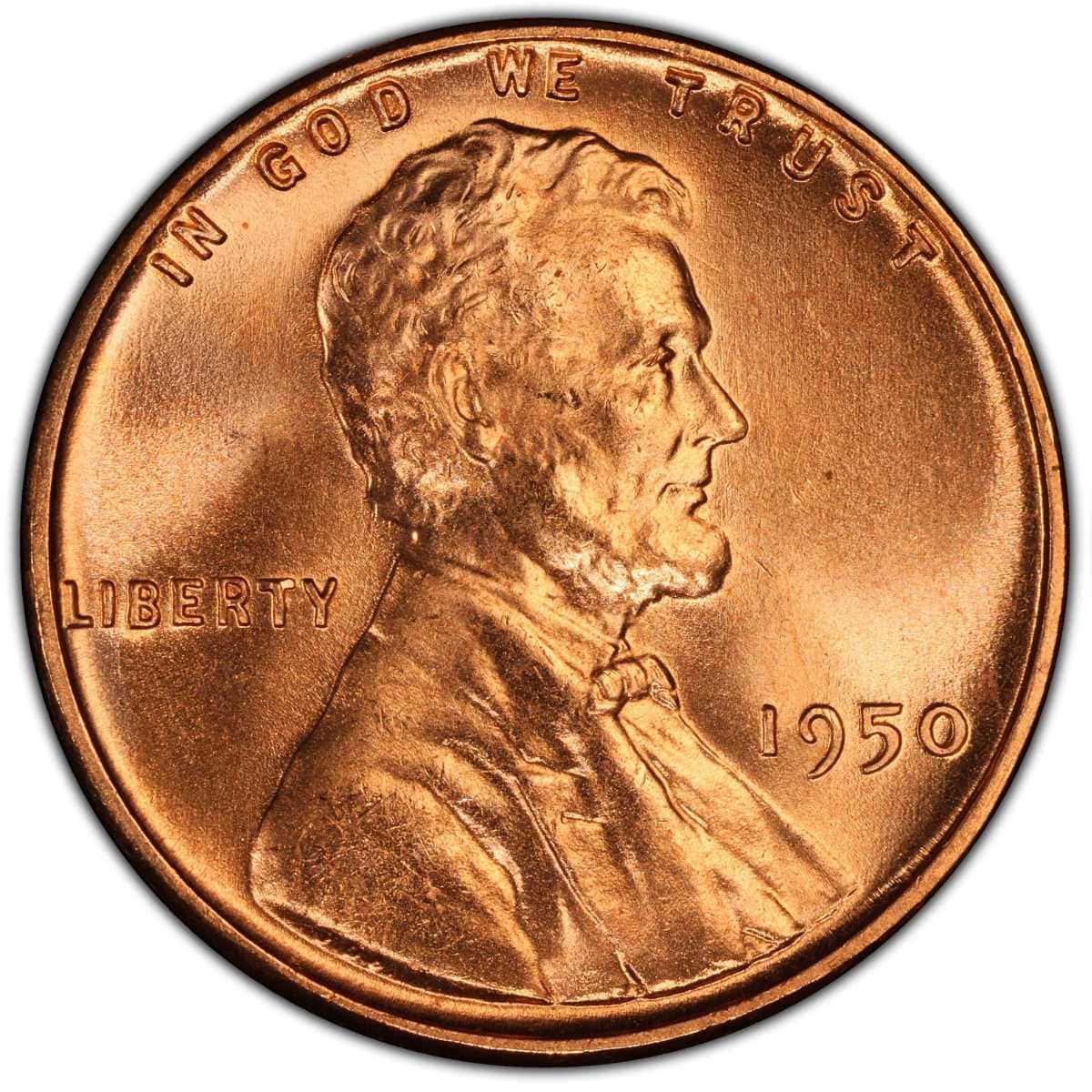
| Mint Location | Mintage | Coin Series | Estimated Value |
| Philadelphia | 272,686,386 | 1950 1C MS BN | $0.05 to $12.50 |
| 1950 1C MS RB | $0.75 to $24.00 | ||
| 1950 1C MS RD | $2.50 to $2,100.00 | ||
| 1950 1C PF BN | $22.00 to $70.00 | ||
| 1950 1C PF RB | $25.00 to $170.00 | ||
| 1950 1C PF RD | $35.00 to $3,500.00 | ||
| 1950 1C PF RDC | $77.50 to $8,600.00 | ||
| 1950 1C PF RDU | $350.00 to $26,000.00 | ||
| Denver | 334,950,000 | 1950 D 1C MS BN | $0.05 to $12.50 |
| 1950 D 1C MS RB | $0.75 to $25.00 | ||
| 1950 D 1C MS RD | $2.50 to $1250.00 | ||
| San Francisco | 118,505,000 | 1950 S 1C MS BN | $0.50 to $12.50 |
| 1950 S 1C MS RB | $0.75 to $8.50 | ||
| 1950 S 1C MS RD | $2.50 to $3,300.00 |
With many classifications, the base price for the 1950 Penny Value varies. The starting value for the regular strike coins is not that far from the face value at $0.05 to $0.50. Meanwhile, the proof coin has a higher value at $22 to $35.
1950 Wheat Penny Details
- Category: Lincoln Cents, Wheat Reverse
- Weight: 3.11g
- Diameter: 19.05mm
- Composition:95% copper, 5% tin and zinc
- Obverse and Reverse Designer: Victor D. Brenner
- Edge: Plain
The US Mint made history in 1909 by planning to release the first US coin to feature a real person. The new one-cent would honor President Abraham Lincoln on his 100th birthday.
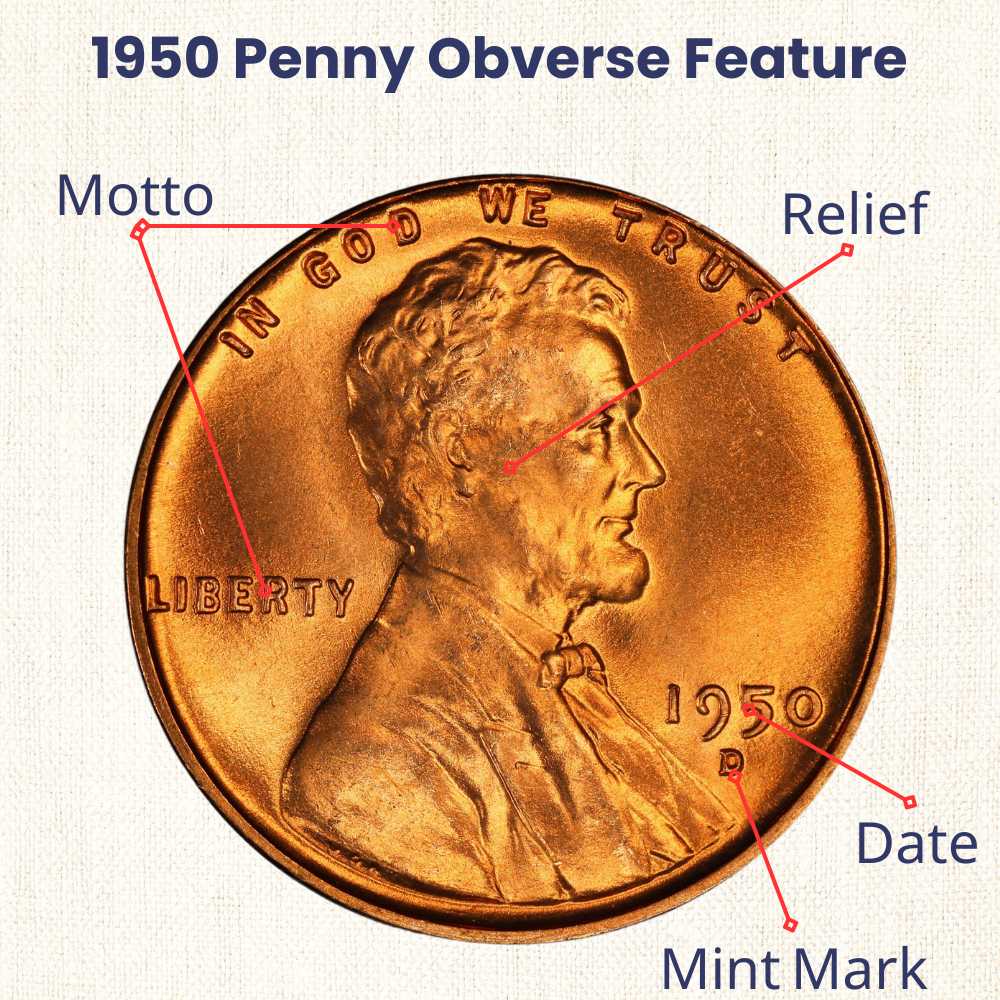
The most prominent aspect of Brenner’s design for the penny was using a portrait of Abraham Lincoln as a centerpiece. Present on the top part of the coin is “IN GOD WE TRUST” ─ the first time it was included on a cent design. On the left side of the portrait is “LIBERTY,” while the mint year was placed on the right along with the mintmark.
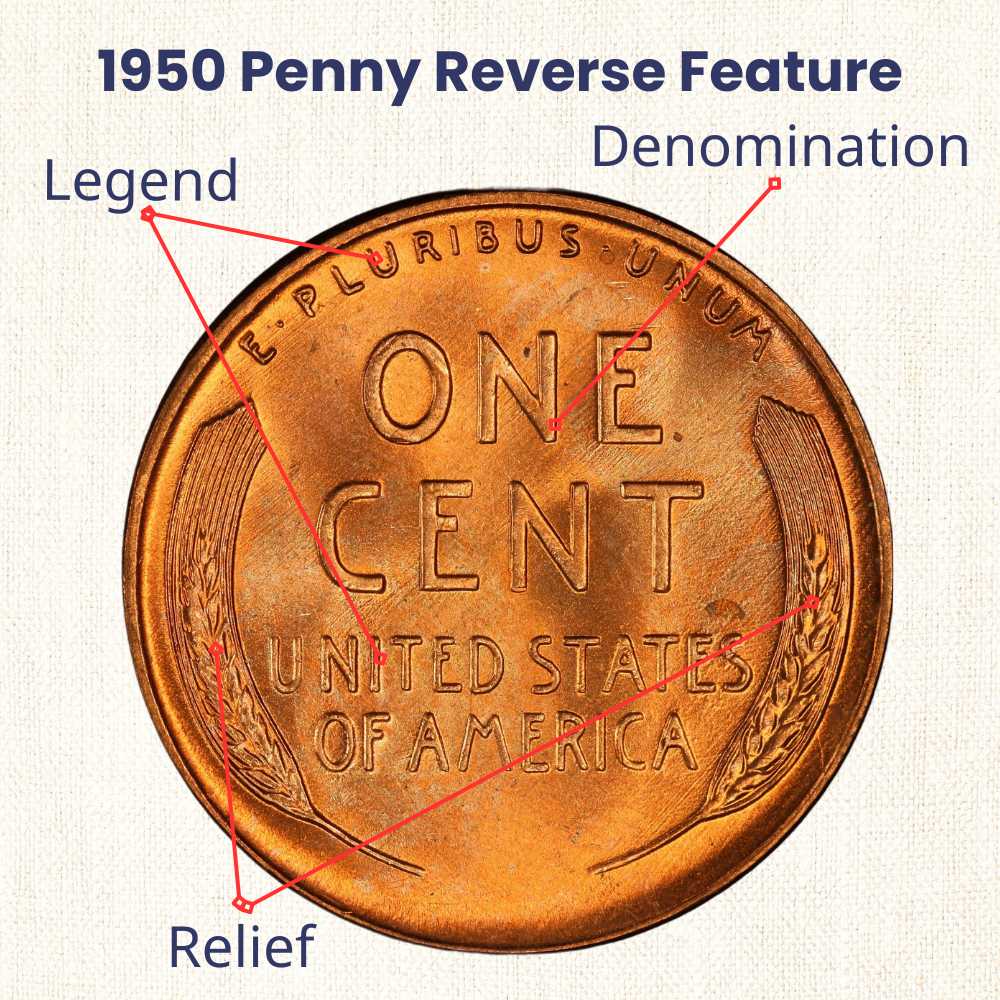
The coin’s reverse design showcases two clusters of wheat, framing the phrases “ONE CENT” and “UNITED STATES OF AMERICA.” On top of the coin, the motto “E PLURIBUS UNUM” is present.
How Much is a 1950 Penny?
One noticeable feature of these coins is their vibrant red shine when freshly struck. These coins have a unique characteristic: they start with a bright and captivating red hue when brand new.
But as time passes, this striking red color fades away and is replaced with a deep brown patina. Before we get into the estimated value for the 1950 Penny, let’s get into the special strike characters that will dictate their price. Same with copper coins, most bronze ones also have these designations.
To distinguish the level of red and brown on the coin’s surface, NGC has implemented a grading system that includes three descriptive letters:
- RD: Red has 85% of its original red luster remaining. Most coins with this label are struck with a higher quality planchet or newer dies.
- RB: As these coins age, the red luster may diminish, resulting in a deeper red-brown hue. These are classified as red-brown and must still have at least 15% of their original luster to be considered in this category.
- BN: Finally, if the coin has lost more than 85% of its red luster due to circulation or worn dies, it is called Brown. This is the most common type of coin you’ll find.
These particular strikes allow a more precise evaluation of the coin’s condition. If you want to learn more about these labels, you can check it here.
1950 P Penny Value
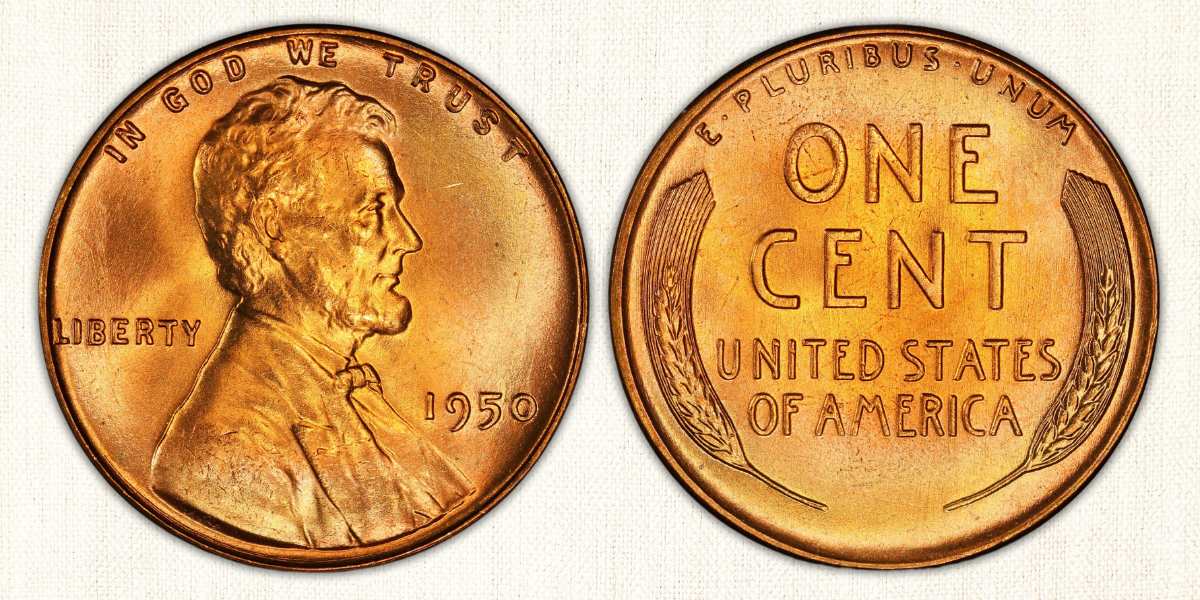
While many coins from this time were struck well, this specific mint location often displays a dull red hue. This is in comparison to the bright shades on pennies minted during World War II and the subsequent years of the 1950s.
| 1950 Regular Strike P Penny Grading and Value | |||
| Grading | 1950 1C MS BN | 1950 1C MS RB | 1950 1C MS RD |
| Good | $0.05 | / | / |
| Fine | $0.05 | / | / |
| Extremely Fine | $0.10 | / | / |
| AU 50 | $0.10 | / | / |
| AU 58 | $0.15 | / | / |
| MS 60 | $0.50 | $0.75 | $2.50 |
| MS 61 | $0.75 | $1.50 | $3.50 |
| MS 62 | $1.00 | $2.50 | $5.00 |
| MS 63 | $1.50 | $3.50 | $6.50 |
| MS 64 | $2.50 | $5.00 | $10.00 |
| MS 65 | $5.00 | $12.50 | $22.50 |
| MS 66 | $12.50 | $24.00 | $85.00 |
| MS 67 | / | / | $2100 |
Also, most of the struck coins from this mint location have a lower quality. The result is a higher amount of brown pennies, primarily for circulation. This affected the price, giving the 1950 BN pennies a value of $0.05 to $12.50.
The RB coin is the in-between value at $0.75 to $24. The value of the MS-64 red-brown coins is almost double than of the brown ones.
Lastly, the RD coin has a starting price of $2.50. The notable characteristic of the 1950 RD Penny in MS-67 condition from the Philadelphia Mint is its rareness. This gives the particular grade a high jump in a price of $2,100.
1950 D Penny Value
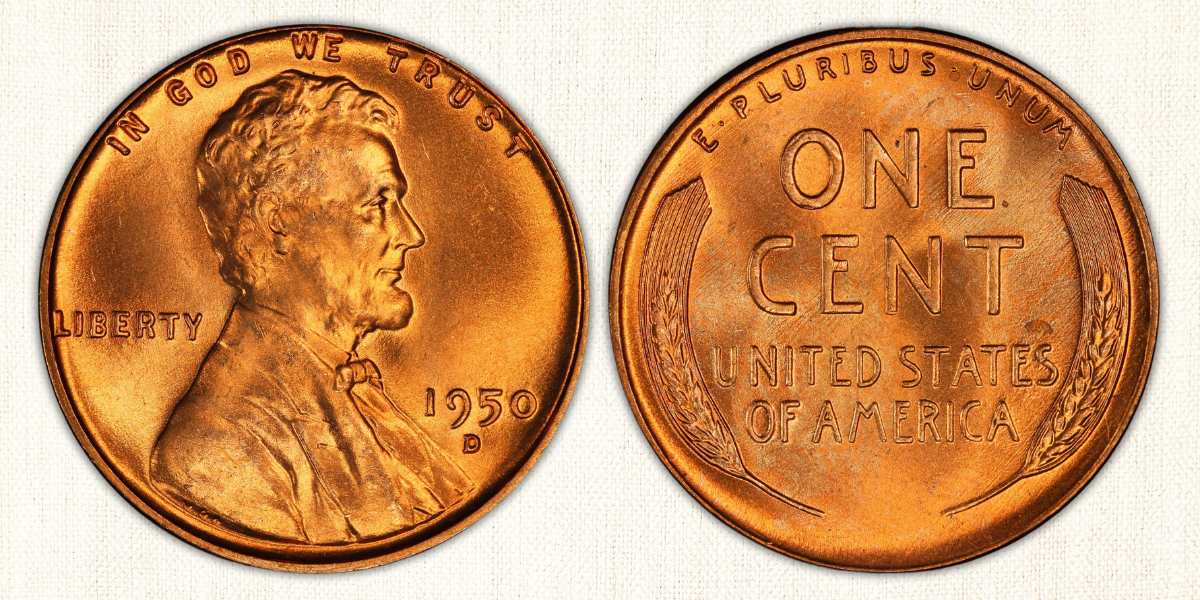
The year 1950 was a busy production for the Denver Mint as they produced the most number of pennies, totaling 334,950,000.
Despite being in the later part of the Lincoln Cent production, the commonly found 1950 D Penny is mainly seen as a well-crafted coin. It usually comes with precise details from new or seldom-used dies. It has a pleasant shine and color overall, but some errors such as die breaks or cud, may be present due to handling.
| 1950 Regular Strike D Penny Grading and Value | |||
| Grading | 1950 1C MS BN | 1950 1C MS RB | 1950 1C MS RD |
| Good | $0.05 | / | / |
| Fine | $0.05 | / | / |
| Extremely Fine | $0.10 | / | / |
| AU 50 | $0.10 | / | / |
| AU 58 | $0.25 | / | / |
| MS 60 | $0.50 | $0.75 | $2.50 |
| MS 61 | $0.75 | $1.50 | $3.50 |
| MS 62 | $1.00 | $2.50 | $5.00 |
| MS 63 | $1.50 | $3.50 | $6.50 |
| MS 64 | $2.50 | $5.00 | $10.00 |
| MS 65 | $5.00 | $14.00 | $21.00 |
| MS 66 | $12.50 | $25.00 | $55.00 |
| MS 67 | / | / | $1,250.00 |
That said, even if the Denver Mint poses more quality than the Philadelphia Mint, the estimated price for the BN coin still remains the same. It has a base of $0.05 and can go up to $12.50. Meanwhile, the RB coins are not far off, with a price of $0.75 to $25.
For the highest quality RD coin, it has a starting value of $2.50. Much like any of the series, the high price goes to the MS-67 RD coin at a whopping $1,250.
1950 S Penny Value
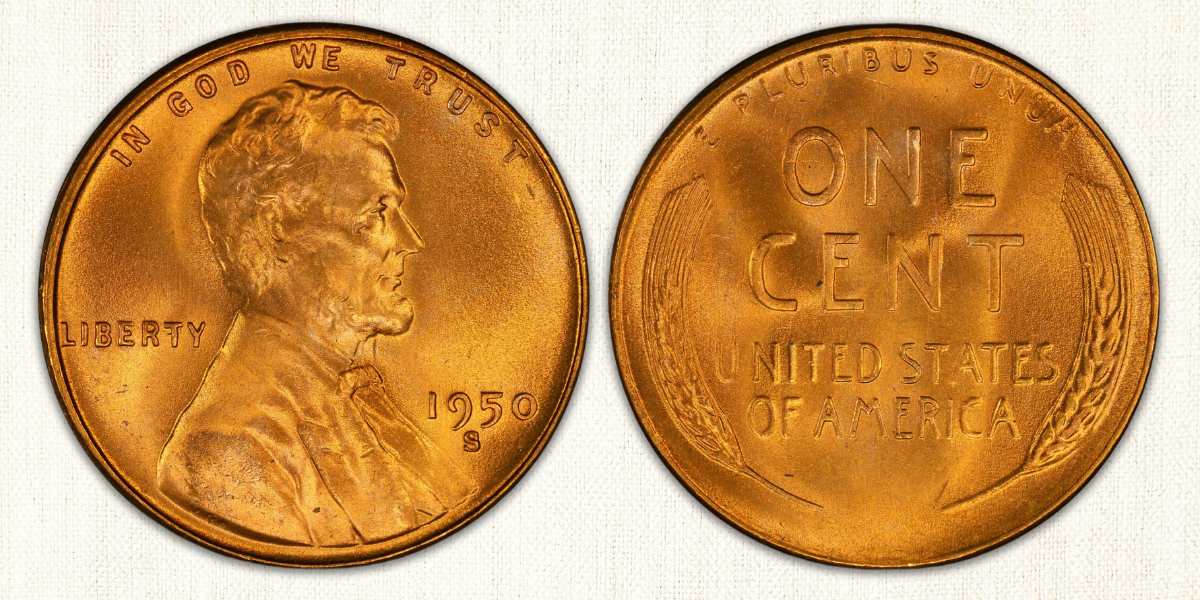
In 1950, the San Francisco Mint’s cent production started to be back up again as the post-war recession was beginning to fade.
| 1950 Regular Strike Penny Grading and Value | |||
| Grading | 1950 1C MS BN | 1950 1C MS RB | 1950 1C MS RD |
| Good | $0.05 | / | / |
| Fine | $0.05 | / | / |
| Extremely Fine | $0.10 | / | / |
| AU 50 | $0.10 | / | / |
| AU 58 | $0.25 | / | / |
| MS 60 | $0.50 | $0.75 | $2.50 |
| MS 61 | $0.75 | $1.50 | $3.50 |
| MS 62 | $1.00 | $2.50 | $5.00 |
| MS 63 | $1.50 | $3.50 | $6.50 |
| MS 64 | $2.50 | $5.00 | $10.00 |
| MS 65 | $5.00 | $11.00 | $16.50 |
| MS 66 | $12.50 | $18.50 | $35.00 |
| MS 67 | / | $50.00 | $375.00 |
| MS 68 | / | / | $3,300.00 |
These coins are known for their vibrant luster, which can disguise imperfections, making them highly sought after. Collectors may encounter difficulties in finding a well-struck penny, although they are more accessible than with previous productions.
The price for the regular BN coin is the same as the two previous mint locations at $0.05 to $12.50. Meanwhile, the RB coin has a price of $0.75 to $50. The RD coin pose the most amount out of any regular strike at $2.50 to $3,300.
1950 Proof Penny Value

The production for the Proof Penny had been on hiatus for seven years before 1950. Proof coin sales did not restart until 1950. The lack of production is due to outdated processes and a lack of support from government authorities.
The US Mint was restricted by an annual budget that often ran out before the end of the fiscal year, forcing it to surrender any profits made from coin production. This made it difficult for them to justify making unique proof coins each year.
However, in 1950, it was discovered that profits from one year’s sales could be used towards the following year’s costs, allowing production to resume.
| 1950 Penny PF Grading and Value | |||
| Grading | 1950 1C PF BN | 1950 1C PF RB | 1950 1C PF RD |
| MS PF 62 | $22.00 | $25.00 | $30.00 |
| MS PF 63 | $25.00 | $30.00 | $40.00 |
| MS PF 64 | $28.50 | $35.00 | $58.00 |
| MS PF 65 | $35.00 | $50.00 | $90.00 |
| MS PF 66 | $70.00 | $80.00 | $200.00 |
| MS PF 67 | / | $170.00 | $350.00 |
| MS PF 68 | / | / | $3,500.00 |
Much like the regular strike pennies, the proof coins have the same three strike characters. The Proof BN coins have a price of $22 to $70. Meanwhile, the RB is not that far, with a starting price of $25 and the highest MS-67 coin going up to $170.
RD still holds the highest amount of estimated value at $30 to $3,500. Currently, only 16 MS-68 RD Penny are graded according to the census, which makes it very rare and sought-after in auctions.
1950 Cameo and Ultra Cameo Proof Penny Value
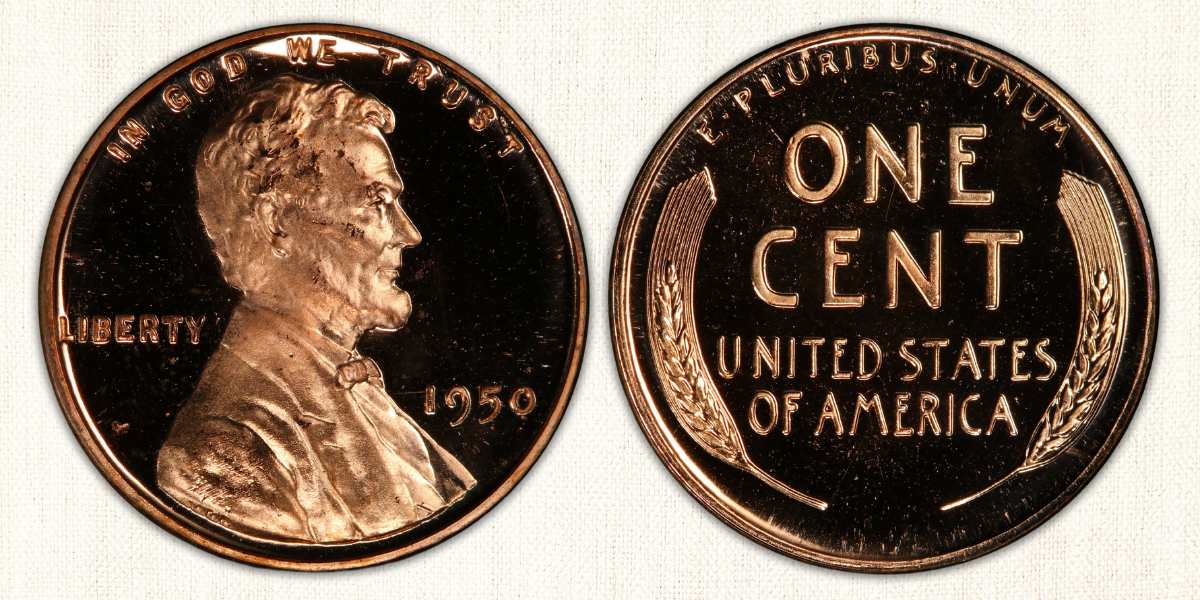
One significant difference between pre-war and post-1950 proof coins is the presence of Cameo and Ultra Cameo proofs. As these coins are relatively rare compared to total production numbers, they are highly sought after by collectors.
Unlike earlier years when these types of proofs were scarce, they are now considered more collectible items among enthusiasts as they were often minted in larger quantities.
| 1950 Penny PF Grading and Value | ||
| Grading | 1950 1C PF RDC | 1950 1C PF RDU |
| MS PF 63 | $77.50 | $350.00 |
| MS PF 64 | $155.00 | $425.00 |
| MS PF 65 | $280.00 | $1,000.00 |
| MS PF 66 | $675.00 | $2,000.00 |
| MS PF 67 | $2,200.00 | $8,500.00 |
| MS PF 68 | $8,600.00 | $26,000.00 |
That said, the RDC and RDU 1950 Penny provide the most value than any designations. For the Red Cameo, it has a price of $77.50 to $8,600. Meanwhile, the Ultra Deep Cameo poses a higher price at $350 to $26,000.
1950 Penny Error Coins
As the Lincoln Cents is coming to an end, the dies used are primarily old. There is a common occurrence of broken areas on the coin, called “die breaks.” This is due to high production numbers, excessive use of dies, and insufficient hardening techniques during the 1950s. As a result, die and striking errors became more frequent during this time period compared to previous years.
Here are some of the error coins that came from the 1950 Penny production.
1950 Lincoln Wheat Cent Penny Die Error
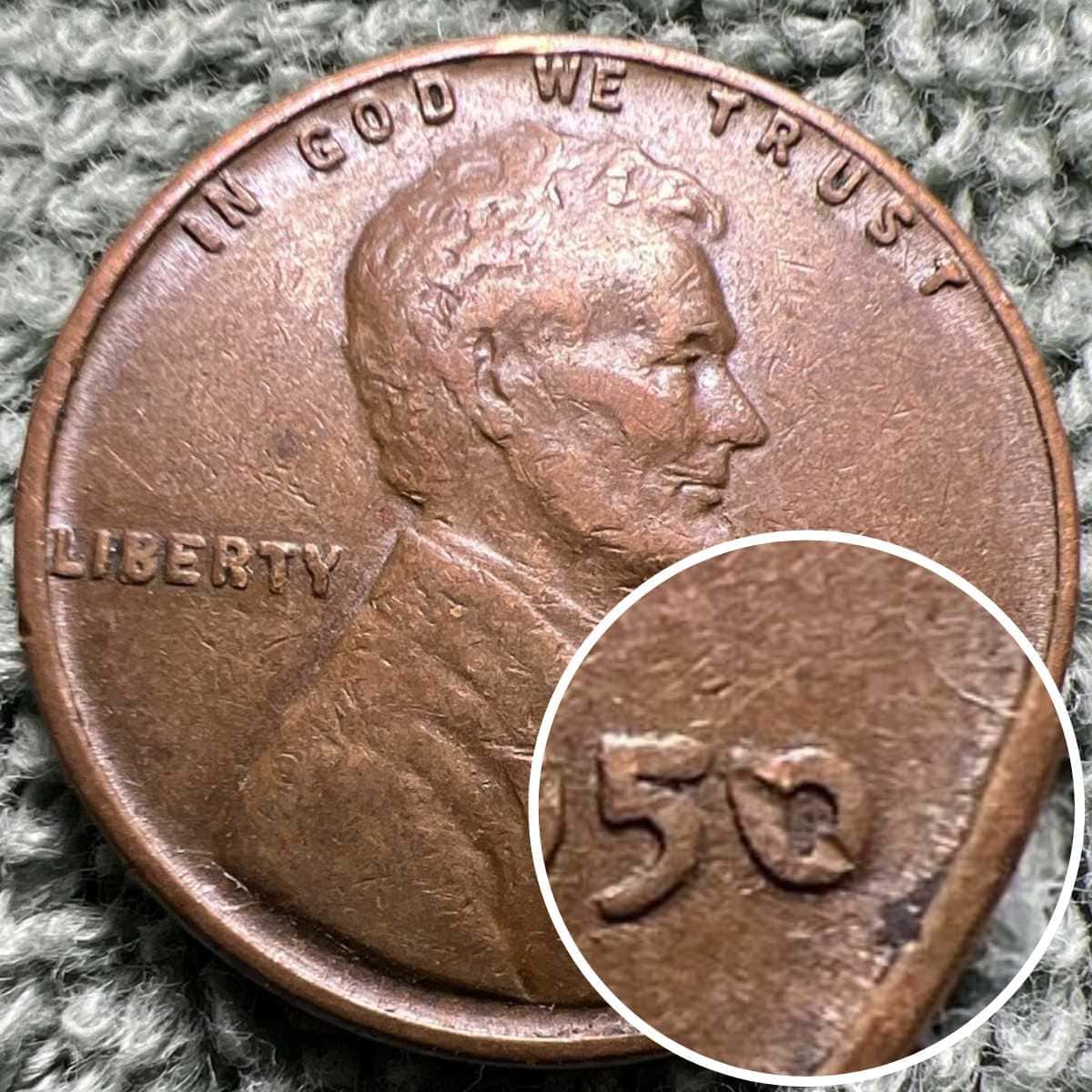
This particular coin has a striking die error. It’s more noticeable in the mint year of the coin, having a slash in the number ‘0.’ It’s up for $600.
1950 Lincoln Wheat Penny Reverse Struck Thru Through Error
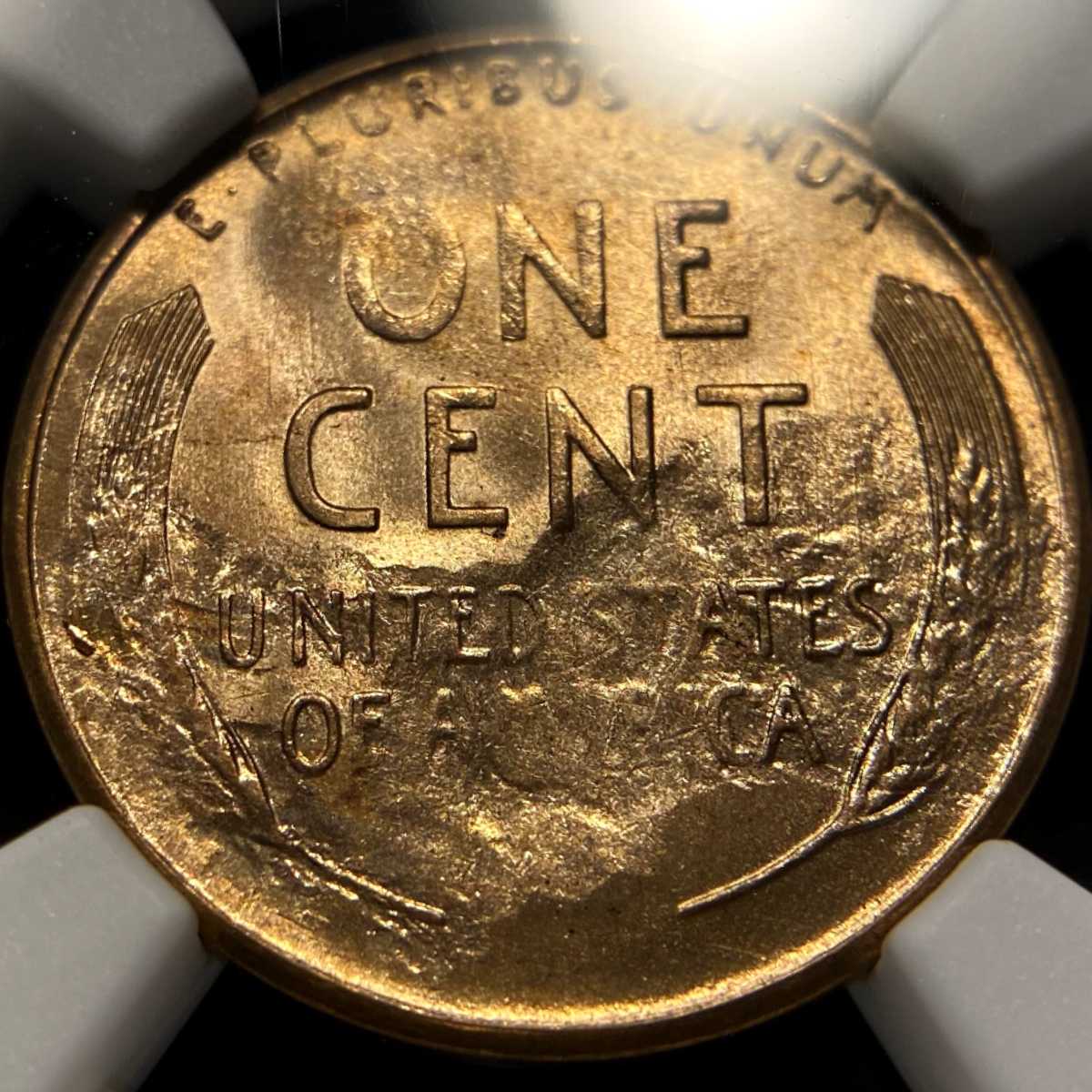
A struck-through error refers to a distinctive mark caused by external debris disrupting the manufacturing process. This mistake results in an indentation being left on the coin’s surface, resulting in a one-of-a-kind appearance.
This particular coin has a struck-through error on the reverse side, causing the elements to be all muddled. It’s up for sale for $369.
1950 D Lincoln Wheat Penny Struck Off Center

An off-center error happens when the blank planchet does not line up correctly between the two design dies. As a result, only part of the design is imprinted onto the coin. If a noticeable portion of the design is missing, this is considered an official off-center strike, such as this D Penny up for $274.95.
In Conclusion
The 1950 does not have significant value for the regular strike and circulated coins. As long as the coin holds an MS-64 or higher grade, it’s guaranteed to be more valuable. Some errors and RD coins can reach prices of hundreds or even thousands of dollars!
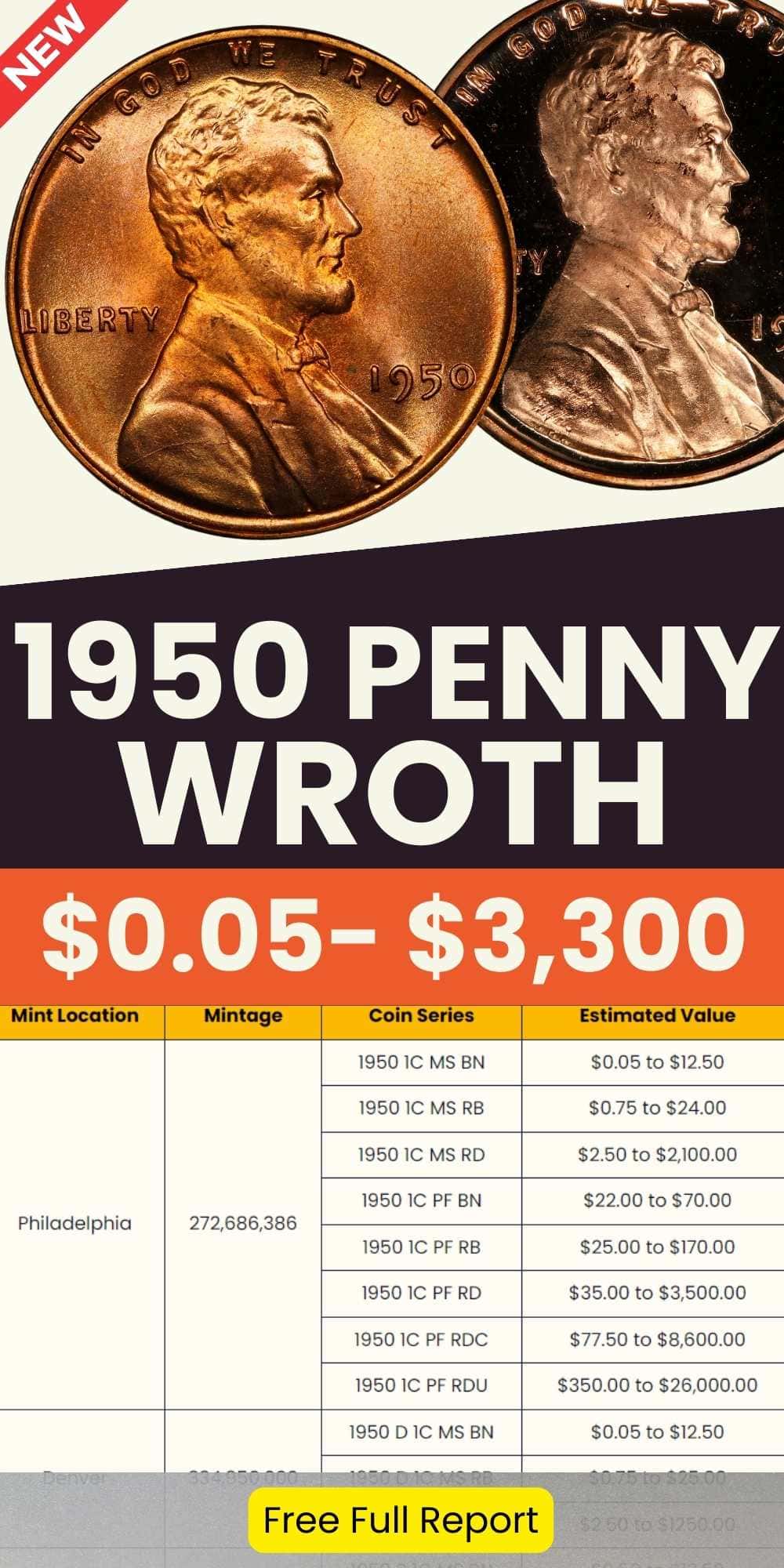

Jenson is a professional numismatist, a dedicated coin collector, a graduate of the College of Business at Oregon State, a life member of the American Numismatic Association (ANA), and an overall coin nerd. He is the founder of Coin Value List.
